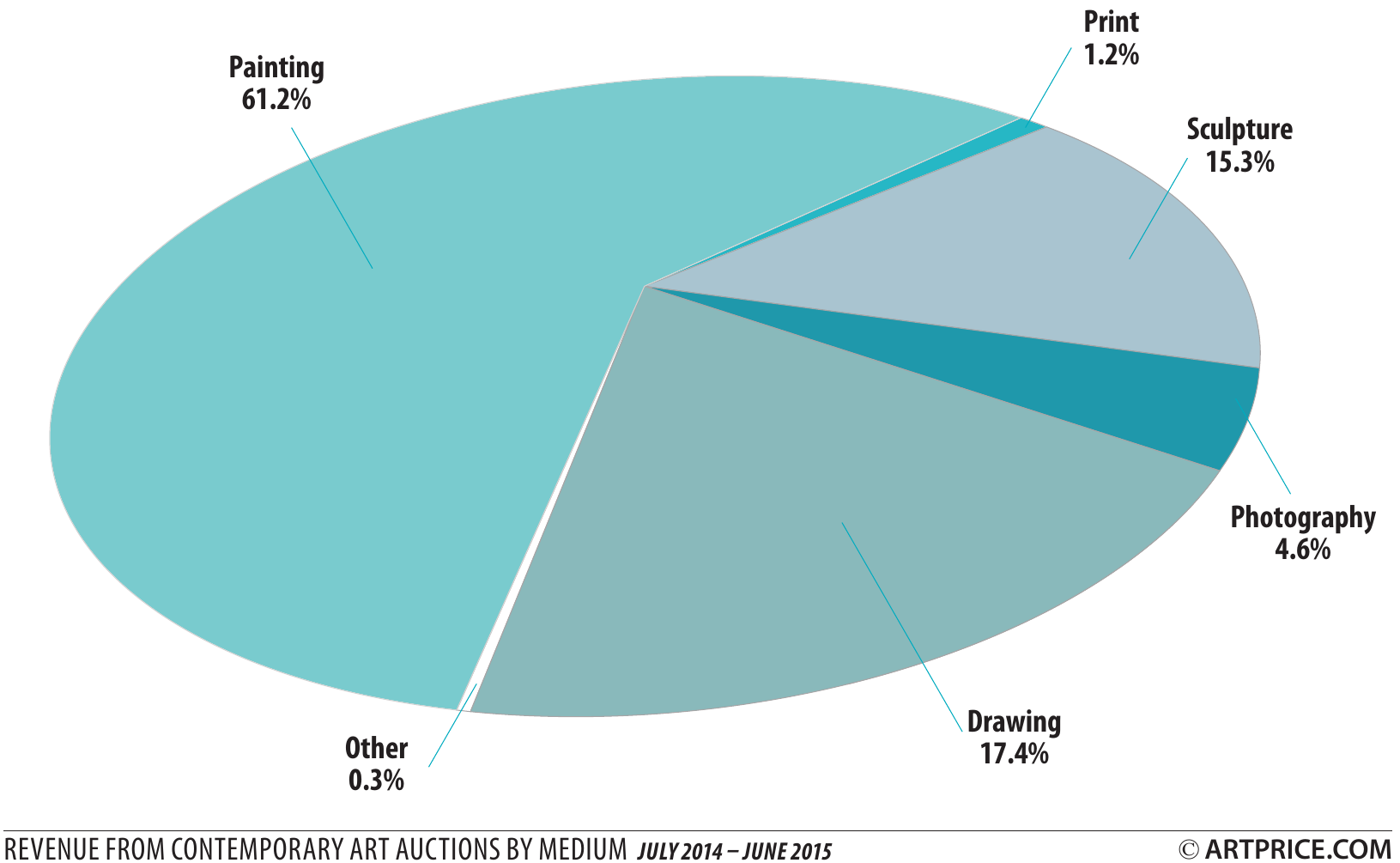Europe’s turnover largely dependent on London
European artists are well represented on the glo-bal auction market. Generating a quarter of global Contemporary art auction turnover, they account for a larger share than Chinese artists1. After the Americans and the Chinese, the best performing nationalities on the Contemporary art auction market are the Germans (10.8% of the market), followed by the British (10.7%), the Italians (2.6%), the Japanese (2%), the Indians (1.5%), the Swiss (0.9%), the Brazilians (0.8%) and the French (0.8%).
It is difficult not to notice France’s low position in this ranking. Clearly France does not provide a sufficiently favourable environment for its artists to shine in the ultra-competitive global market. Under-represented in the global rankings, French artists often emigrate in order to enhance their chances of survival and success, their home market being insufficiently dynamic. Although France is the 4th best national marketplace for Contemporary art, its turnover is marginal ($35.5 million, i.e. 2% of global turnover) compared with the three major art market powers. France’s auction market is particularly lacklustre with more than half the works offered remaining unsold (56%). Not considered one of the best markets for the sale of prestige artworks, the French market maintains a certain dynamism on the back of a denser and cheaper offer than other countries2.
While the French auction market is stagnating (it would have completely collapsed a long time ago were it not for Christie’s and Sotheby’s Parisian outlets3), the UK’s auction turnover on Contemporary art has posted an extraordinary growth rate of 74%, confirming London’s growing power on the global art map (London accounted for 99% of the UK’s Contemporary art auction turnover). With a turnover total of $410 million, representing 23% of global auction turnover from Contemporary art, the UK belittles the turnover generated on Continental Europe. It retains its 3rd position in the country ranking and has considerably narrowed the gap with China. The previous year, the two powers were separated by $630 million. This year the gap is only $130 million.
London is the historical European marketplace. Christie’s, the world’s most powerful auction operator, was founded in London in 1766. Today the firm largely dominates its international rivals on the Contemporary art sector, accounting for no less than 37% of the market’s global turnover4. After New York, London is where Christie’s, Sotheby’s and Phillips generate their best results, often with the same artists (Peter DOIG, Christopher WOOL, Jean-Michel BASQUIAT, Martin KIPPENBERGER are the best London performers in terms of turnover). Nevertheless, London does have a certain specificity, particularly since Christie’s has managed to revitalise demand for works created by the Young British Artists in the 1990s.
The YBAs, the “young” artists supported by Charles Saatchi in his eponymous gallery in 1992 and then later at the Royal Academy of Arts in 19975, have recently provided a substantial boost to the London Contemporary art market: Damien HIRST was responsible for the 10th best auction result of the 12-month period (Lullaby Winter fetched $4 million) and there were new auction records for Chris OFILI, Malcolm MORLEY and the Chapman brothers. Chris OFILI’s record now stands at $4.5 million for his black Madonna accompanied by images of genitalia, and Malcolm MORLEY crossed the million-dollar threshold for the first time with a work from the Charles Saatchi Collection6. Lastly, Dinos & Jake CHAPMAN reached $665,000 with their sculpture inspired by Goya’s Désastres de la guerre7(which also elicited controversial reactions at the Sensation shows). These new records, reflecting a concerted effort to reposition the YBAs in the market’s top bracket, also illustrate the market’s sensitivity to the pedigree and provenance of artists and their works.
London is also propping up the prices of the major Anglo-Indian artists likeAnish KAPOOR and Bharti KHER (who generate 55% of their auction turnover in London), Rashid RANA (62% in London) and, above all, Raqib SHAW (94% in London), the most sought after Anglo-Indian artist along with Anish KAPOOR. Still in 6-digit results since 2007, Raqib SHAW has returned to centre stage this year with two works fetching above the million-dollar line1in London last June, one at Phillips, the other at Christie’s.)

- 25% of the global turnover was generated by European artists versus 21% by Chinese artists.
- France represents 10% of global transaction volume (lots sold).
- The Anglo-Saxon auction houses now dominate France’s secondary art market. Sotheby’s and Christie’s today account for 2/3 of France’s Fine Art auction turnover, all periods combined.
- Christie’s global turnover from Contemporary art was $649 million for the 2014/2015 period.
- SS Amsterdam in Front of Rotterdam, fetched $1.8 million.
- Great Deeds Against the Dead
- Including fees.
Top 10 auction sales revenue July 2014 – June 2015
| Rank | Artist | Lot | Price | Sale |
|---|---|---|---|---|
| 1 | Jean-Michel BASQUIAT (1960-1988) | The Field Next to the Other Road (1981) | $37,125,000 | 13 may 2015, christie’s new york |
| 2 | Christopher WOOL (1955) | Untitled (Riot) (1990) | $29,930,000 | 12 may 2015, sotheby’s new york |
| 3 | Jeff KOONS (1955) | Balloon Monkey (Orange) (2006-2013) | $25,925,000 | 12 nov. 2014, christie’s new york |
| 4 | Peter DOIG (1959) | Swamped (1990) | $25,925,000 | 11 may 2015, christie’s new york |
| 5 | Martin KIPPENBERGER (1953-1997) | Untitled (1988) | $22,565,000 | 12 nov. 2014, christie’s new york |
| 6 | Peter DOIG (1959) | Pine House (Rooms for Rent) (1994) | $18,085,000 | 12 nov. 2014, christie’s new york |
| 7 | Peter DOIG (1959) | Gasthof (2002-2004) | $16,948,124 | 1 July 2014, christie’s London |
| 8 | Martin KIPPENBERGER (1953-1997) | Untitled (1988) | $16,405,000 | 13 may 2015, christie’s new york |
| 9 | Jeff KOONS (1955) | Pink Panther (1988) | $15,845,000 | 12 nov. 2014, christie’s new york |
| 10 | Christopher WOOL (1955) | Untitled (1990) | $14,165,000 | 12 nov. 2014, christie’s new york |





 0
0
